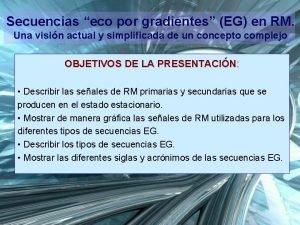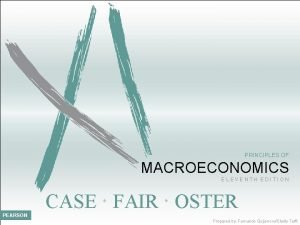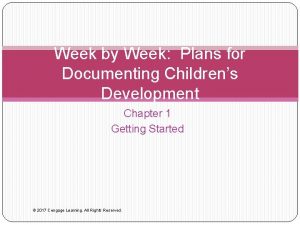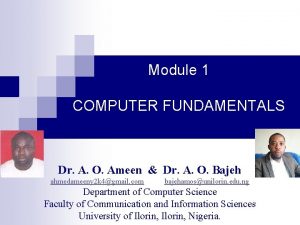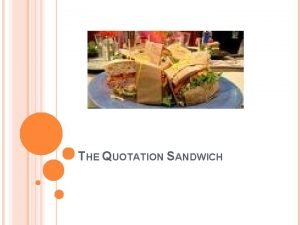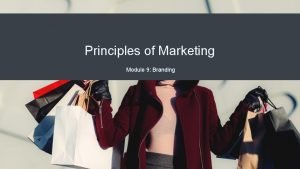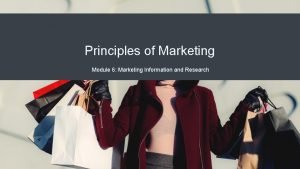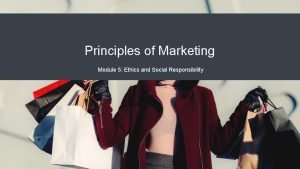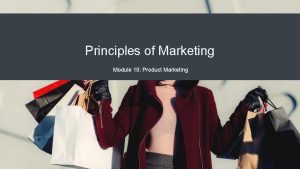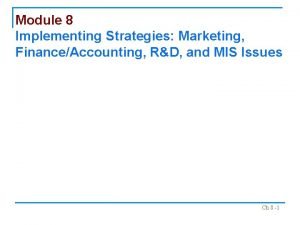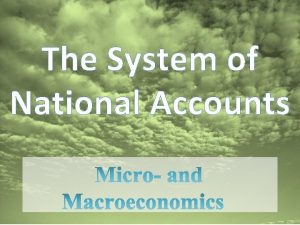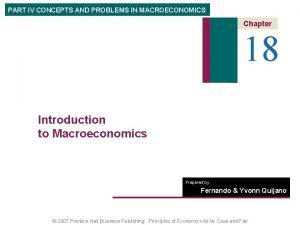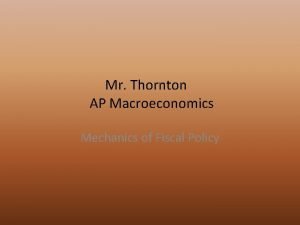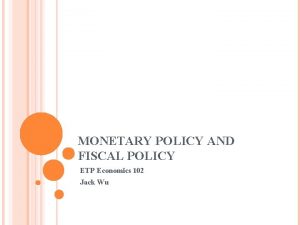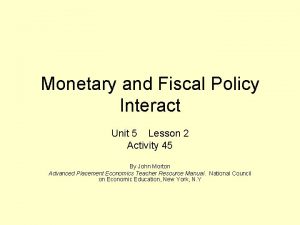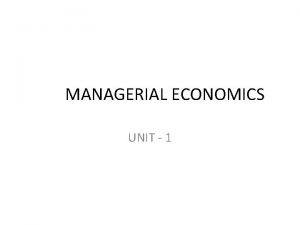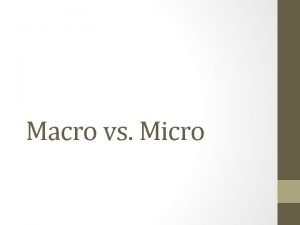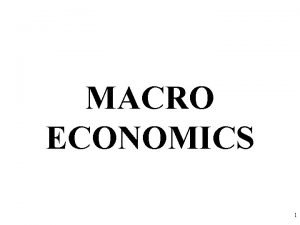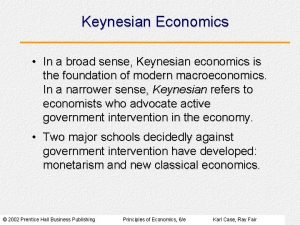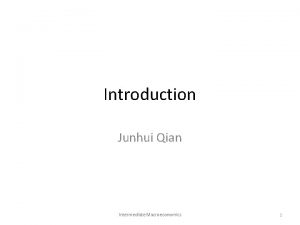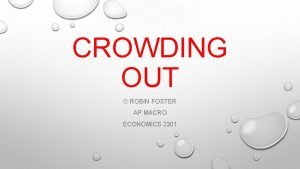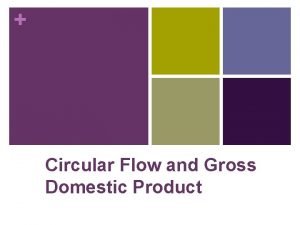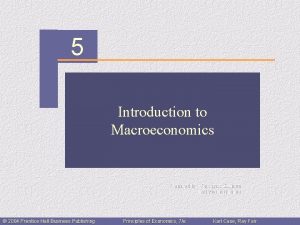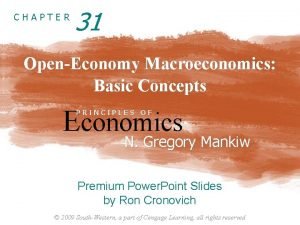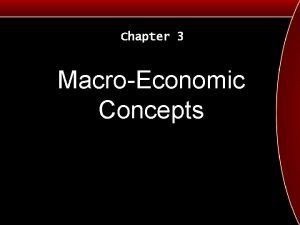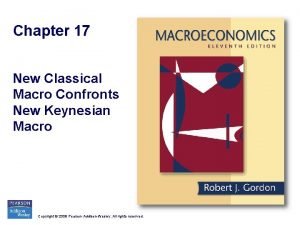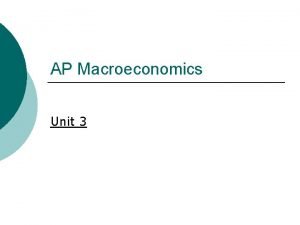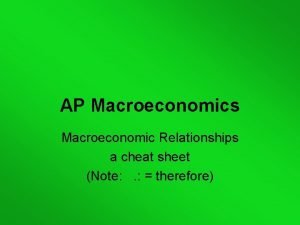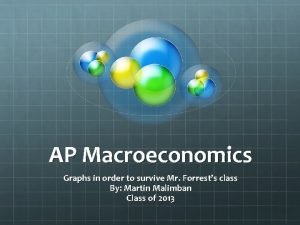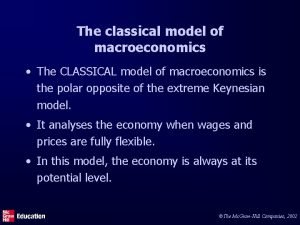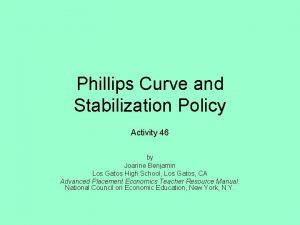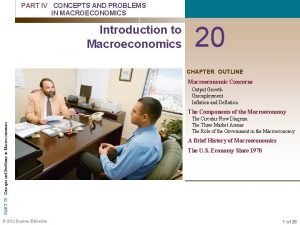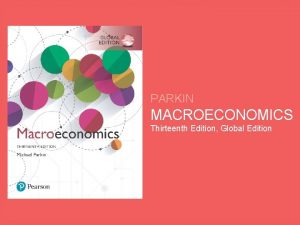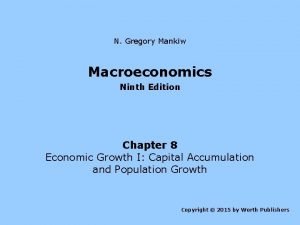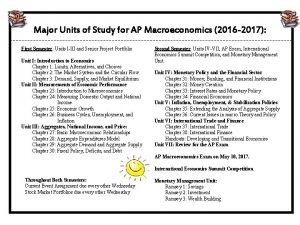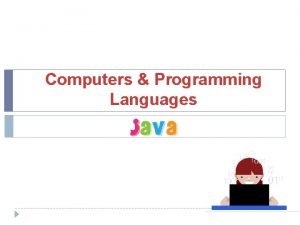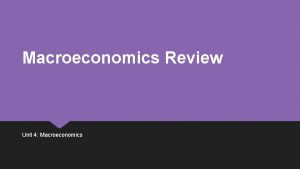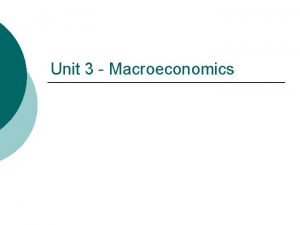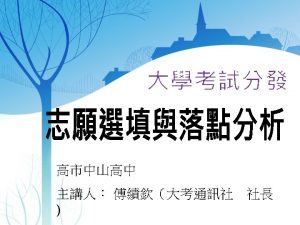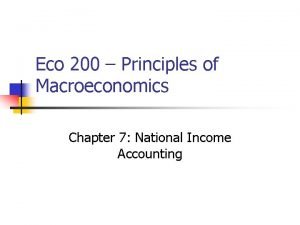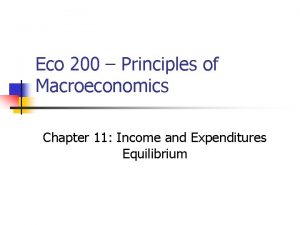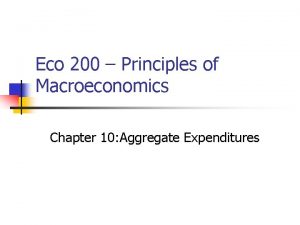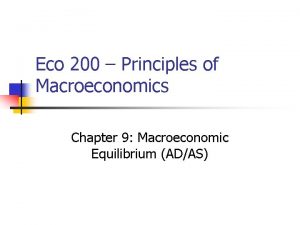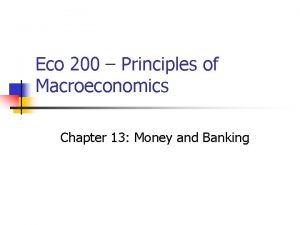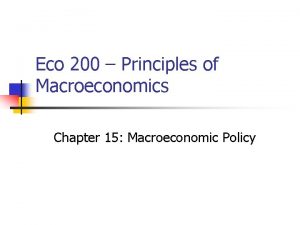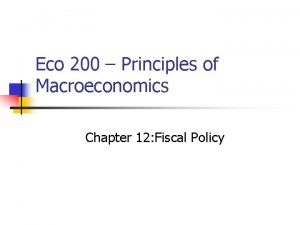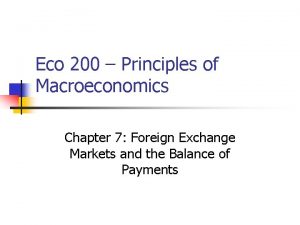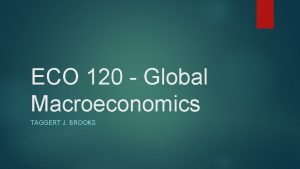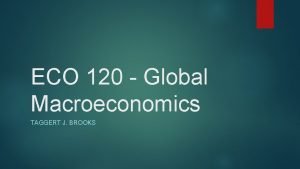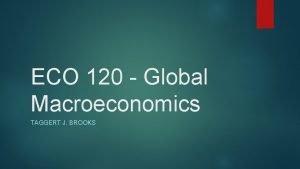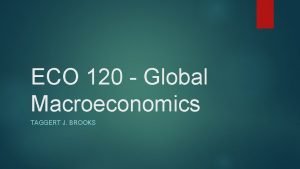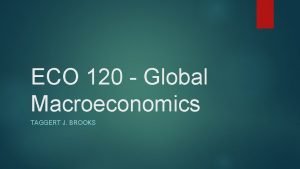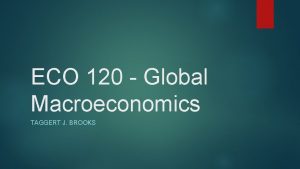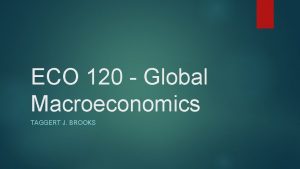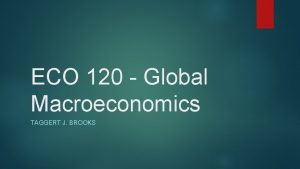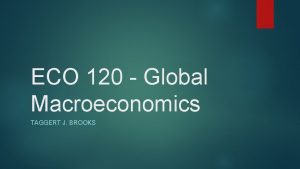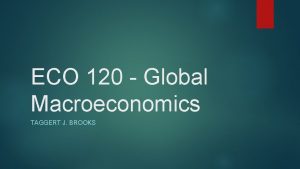ECO 102 Principles of Macroeconomics Module Outline Week







































- Slides: 39

ECO 102 Principles of Macroeconomics

Module Outline Week Topics 1 A First Look at Macroeconomics 2 Measuring GDP and Economic Growth 3 Monitoring Cycles, Jobs, and the Price Level 4 Expenditure Multipliers: The Keynesian Model 5 Aggregate Supply and Aggregate Demand 6 Money, Banks, and the Central Bank 7 Money, Interest, Real GDP, and the Price Level 8 Inflation 9 The Business Cycle 10 Fiscal Policy 11 Monetary Policy 12 -13 14 IS-LM Model International Finance

Textbook and References Textbook Parkin, M (2008) Economics, 9 th edition. Reference Mankiw, N. G. (2003) Macroeconomics, 5 th edition. • Specifically for the Topic on IS-LM model.

ECO 102: Topic 1 A First Look at Macroeconomics

After studying this chapter you will be able to Describe the origins and issues of macroeconomics Describe the trends and fluctuations in economic growth and explain the benefits and costs of economic growth Describe the trends and fluctuations in unemployment and explain why unemployment is a problem Describe the trends and fluctuations in inflation and explain why inflation is a problem Describe the trends and fluctuations in surpluses, deficits, and debts and explain why they matter Identify the macroeconomic policy challenges and list the tools available for meeting them

Origins of Macroeconomics Modern macroeconomics dates from the Great Depression, a decade (1929 -1939) of high unemployment and stagnant production throughout the world economy. John Maynard Keynes book, The General Theory of Employment, Interest, and Money, began the subject.

Issues of Macroeconomics Business Cycles and Economic Growth Job and Unemployment Inflation and Deflation Surpluses, Deficits, and Debts at a National Level Macroeconomic Policies and Schools of Economic Thought

Economic Growth and Business Cycles Economic growth is the expansion of the economy’s production possibilities—an outward shifting PPF. • Real GDP (real gross domestic product) is the value of the total production of all the nation’s farms, factories, shops, and offices, measured in the prices of a single year. • In real GDP, the effect of price change (i. e. inflation or deflation) is eliminated. We measure economic growth by the increase in real GDP.

Economic Growth and Business Cycles Economic Growth in the United States Figure 20. 1 shows real GDP in the United States from 1960 to 2005. The figure highlights: § Growth of potential GDP § Fluctuations of real GDP around potential GDP

Economic Growth and Business Cycles Growth of Potential GDP is the value of production when all the economy’s labor, capital, land, and entrepreneurial ability are fully employed.

Economic Growth and Business Cycles Fluctuations of Real GDP Around Trend Real GDP fluctuates around potential GDP in a business cycle—a periodic but irregular upand-down movement in production.

Economic Growth and Business Cycles Every business cycle has two phases: 1. A recession 2. An expansion and two turning points: 1. A peak 2. A trough Figure 20. 2 on the next slide illustrates these features of the business cycle.

Economic Growth and Business Cycles A recent business cycle in the United States

Economic Growth and Business Cycles A recession is a period during which real GDP decreases. An expansion is a period during which real GDP increases.

Economic Growth and Business Cycles Figure 20. 3 shows the long-term growth trend and cycles.

Economic Growth and Business Cycles Benefits and Costs of Economic Growth Benefits: • Higher future consumption, e. g. more health care for the needy, more fund for medical research, better roads, and more to spend on clean air, etc. . • i. e. higher living standard in the future. Costs: • The main cost of growth is forgone current consumption, i. e. lower consumption now. • To sustain growth, resources must be allocated to advancing technology and accumulating capital (e. g. more infrastructure) rather than to current consumption. • i. e. giving up current living standard for higher future living standard.

Jobs and Unemployment Jobs In 2006, 143 million people in the United States had jobs. This number is 16 million more than in 1996 and 33 million more than in 1986. The pace of job creation fluctuates with business cycles. During a recession, the number of jobs shrinks. During the 1990 1991 recession, more than 1 million jobs were lost and during the 2001 recession, 2 million jobs disappeared.

Jobs and Unemployment Not everyone who wants a job can find one. In a recession, the number of unemployed is larger. For example, in 1990 -1991 recession, 9 million people were looking for jobs. The unemployment rate is the number of unemployed people expressed as a percentage of all the people who have jobs or are looking for one.

Jobs and Unemployment in the United States Figure 20. 6 shows the unemployment rate from 1926 to 2006.

Jobs and Unemployment During the 1930 s, the unemployment rate hit 25 percent.

Jobs and Unemployment The lowest rate occurred during World War II at 1. 2 percent.

Jobs and Unemployment During recent recessions, the unemployment rate increased but was not as high as in the Great Depression.

Jobs and Unemployment The unemployment rate is never zero. Since World War II, it has averaged 5 percent.

Jobs and Unemployment Why Unemployment Is a Problem Unemployment is a serious economic, social, and personal problem for two main reasons: § Lost production and incomes • The loss of a job brings an immediate loss of income and production—a temporary problem. § Lost human capital • A prolonged spell of unemployment can bring permanent damage through the loss of human capital.

Inflation and Deflation We measure the level of prices—the price level— as the average of the prices that people pay for all the goods and services that they buy. The Consumer Price Index—the CPI—is a common measure of the price level. We measure the inflation rate as the percentage change in the price level. Inflation arises when the price level is rising persistently. If the price level is falling, inflation is negative and we have deflation.

Inflation and Deflation Inflation in the United States Was low in the 1960 s. Increased in the 1970 s and early 1980 s. Fell during the 1980 s and 1990 s. Increased after 2002.

Inflation and Deflation Unpredictable changes in the inflation rate redistribute income between employers and workers and between borrowers and lenders. A high inflation rate is a problem because it diverts resources from productive activities to inflation forecasting. From a social perspective, this waste of resources is a cost of inflation. Eliminating inflation is costly because it brings a period of greater than average unemployment.

Surpluses, Deficits, and Debts Government Budget Balance If a government collects more in taxes than it spends, it has a government budget surplus. If a government spends more than it collects in taxes, it has a government budget deficit.

Surpluses, Deficits, and Debts Figure 20. 11(a) shows the U. S. federal government budget balance from 1960 to 2005. The budget deficit as a percentage of GDP increases in recessions and shrinks in expansions In 1998, a budget surplus emerged, but the budget deficit reappeared in 2001.

Surpluses, Deficits, and Debts International Surplus and Deficit If a nation imports more than it exports, it has an international deficit. If a nation exports more than it imports, it has an international surplus. Deficits (International or Governmental) Bring Debts

Surpluses, Deficits, and Debts Figure 20. 12(b) shows the U. S. international debt from 1975 to 2005. Until 1986, the United States was a net lender to the world. But with increased deficits, the United States is now a net borrower from the world.

Macroeconomic Policies and Schools of Economic Thought Five widely agreed policy challenges for macroeconomics policies: 1. Boost economic growth 2. Keep inflation low 3. Stabilize business cycle 4. Reduce unemployment 5. Reduce government and international deficits

Macroeconomic Policies and Schools of Economic Thought Two broad groups of macroeconomic policy tools are Fiscal policy—making changes in tax rates and government spending Monetary policy—changing interest rates and changing the amount of money in the economy The government conducts fiscal policy. The Federal Reserve (the Fed) or Central Bank conducts monetary policy.

Macroeconomic Policies and Schools of Economic Thought Short-Term Versus Long-Term Goals Keynes focused on the short-term—on unemployment and lost production. “In the long run, ” said Keynes, “we’re all dead. ” During the 1970 s and 1980 s, macroeconomists became more concerned about the long-term—inflation and economic growth.

Macroeconomic Policies and Schools of Economic Thought Classical and Keynesian Views Economists’ views fall into two broad schools: Classical view: The economy behaves best if the government leaves people free to pursue their own selfinterest. Attempts by the government to improve macroeconomic performance will not succeed. Keynesian view: The economy behaves badly if left alone and that government action is needed to achieve and maintain full employment.

After studying this chapter you will be able to § Describe the origins and issues of macroeconomics • Macroeconomics started with J. M. Keynse in 1930’s. § Describe the trends and fluctuations in economic growth and explain the benefits and costs of economic growth • Normally real GDP shows upward trend – economic growth • With fluctuation around the trend line – business cycle • Major benefits and costs of economic growth: tradeoff between current and future consumption § Describe the trends and fluctuations in unemployment and explain why unemployment is a problem • Unemployment fluctuates with business cycles • Cost of unemployment: lost of production and income, damage on human capital

After studying this chapter you will be able to § Describe the trends and fluctuations in inflation and explain why inflation is a problem • In the US, after WWII, inflation rate peaked in 1970 s and was tamed that. • The redistribution effect of unpredictable inflation is a problem. § Describe the trends and fluctuations in surpluses, deficits, and debts and explain why they matter • After WWII, the US ran government deficit most of the time. • Since mid-1980 s, the US had been running international deficit. • Deficits bring debts, which incur interest payments. § Identify the macroeconomic policy challenges and list the tools available for meeting them

After studying this chapter you will be able to § Identify the macroeconomic policy challenges and list the tools available for meeting them • • • 1. Boost economic growth 2. Keep inflation low 3. Stabilize business cycle 4. Reduce unemployment 5. Reduce government and international deficits Fiscal policy and monetary policy are two broad groups of macroeconomic policy tools • While traditional Keynesian stresses short-term policy goals, e. g. unemployment and lost income, modern macroeconomists emphasized on long-term goals, e. g. growth and inflation. • Classical school believes that the market works well to achieve full employment if it is left alone; Keynesian school believes that market does work and need government intervention to achieve full employment.

THE END
 Refase
Refase Principles of macroeconomics case fair oster
Principles of macroeconomics case fair oster Week by week plans for documenting children's development
Week by week plans for documenting children's development C device module module 1
C device module module 1 The quote sandwich example
The quote sandwich example Principles of marketing quarter 2 module 9
Principles of marketing quarter 2 module 9 Principles of marketing module 7
Principles of marketing module 7 Principles of marketing quarter 2 module 6
Principles of marketing quarter 2 module 6 Business ethics and social responsibility module 5
Business ethics and social responsibility module 5 Principles of marketing module 2
Principles of marketing module 2 Principles of marketing module 10
Principles of marketing module 10 Principles of marketing module 8
Principles of marketing module 8 Macroeconomics examples
Macroeconomics examples Components of macroeconomics
Components of macroeconomics Crowding out effect macroeconomics
Crowding out effect macroeconomics Crowding out effect macroeconomics
Crowding out effect macroeconomics Contractory monetary policy
Contractory monetary policy Managerial economics define
Managerial economics define Liquidity preference theory
Liquidity preference theory Example of micro economics
Example of micro economics Real gdp formula macro
Real gdp formula macro New classical macroeconomics
New classical macroeconomics New classical macroeconomics
New classical macroeconomics Crowding out effect
Crowding out effect 2012 macroeconomics frq
2012 macroeconomics frq N
N Ap macroeconomics-percentage for a 5
Ap macroeconomics-percentage for a 5 Chapter 31 open economy macroeconomics
Chapter 31 open economy macroeconomics Macroeconomics deals with
Macroeconomics deals with New classical macroeconomics
New classical macroeconomics New classical and new keynesian macroeconomics
New classical and new keynesian macroeconomics Ap macro unit 3
Ap macro unit 3 Ap macroeconomics cheat sheet
Ap macroeconomics cheat sheet Ap macroeconomics graphs
Ap macroeconomics graphs Macroeconomics
Macroeconomics Macroeconomics lesson 3 activity 46
Macroeconomics lesson 3 activity 46 Components of macroeconomics
Components of macroeconomics Parkin macroeconomics 13th edition pdf
Parkin macroeconomics 13th edition pdf Mankiw macroeconomics 9th edition
Mankiw macroeconomics 9th edition Ap macro units
Ap macro units
